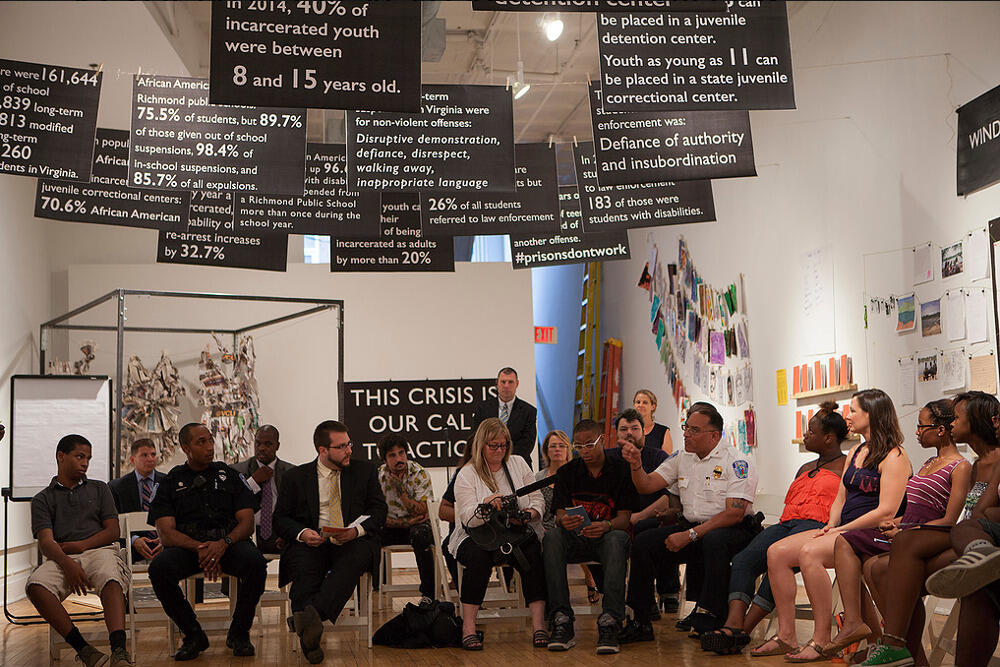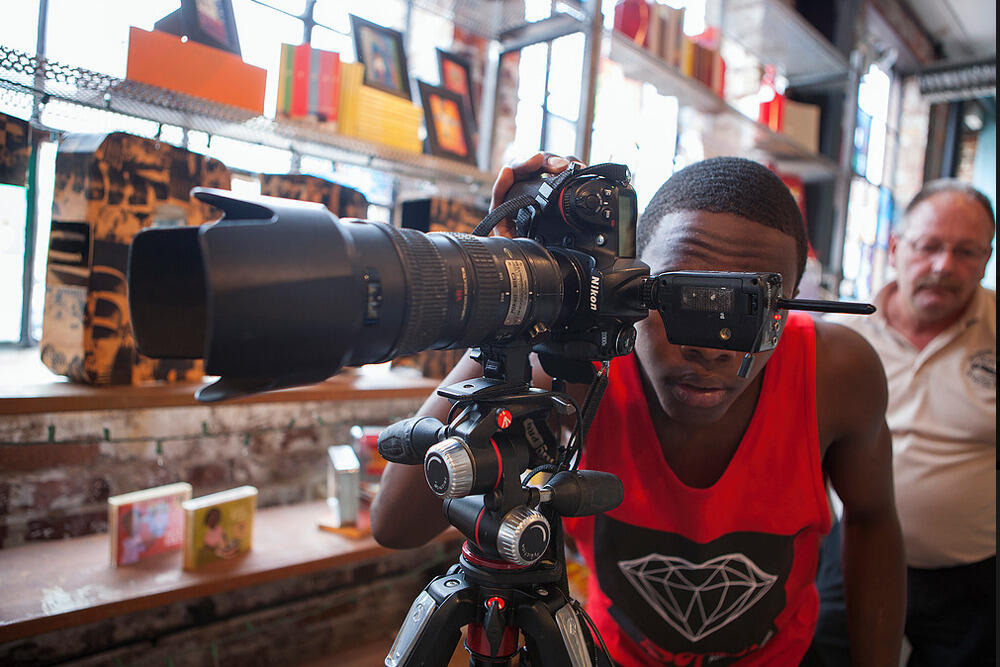
May 24, 2016
Art as activism: Using art to tackle ‘the human rights issue of our time’
Share this story
Do you remember what it was like to be 8 years old? Did you have a gap-toothed grin and perpetually skinned knees? Did you love to play baseball or soccer? Did you spend your childhood incarcerated? That last one may seem preposterous until you consider that in 2014, 40 percent of Virginia’s incarcerated youth were between 8 and 14.
Can you imagine?
Mark Strandquist can.
An artist who prefers to create art with a community, rather than in a community, Strandquist’s community of choice is kids in the juvenile justice system.
“Working very closely with people in that system, you really understand just how much has to change,” Strandquist said. “And how it’s impacting not only the people directly involved in the conviction, but also their family and friends and neighborhoods and communities — at the end of the day, our entire democracy. It’s a huge human civil rights issue. More than anything, it’s the experiences with working with people closely and understanding the human cost of this issue that keeps me active.”
To transform the juvenile justice system, Strandquist, who graduated in 2013 with a major in photography and film from the Virginia Commonwealth University School of the Arts and a minor in sociology, created Performing Statistics, a project that connects incarcerated children and teens with artists, designers, educators and Virginia’s leading policy advocates to help tell their story and give it a human face.
That face is of children with little hope who think nothing will change, said Performing Statistics core organizer Trey Hartt, a Theatre VCU alumnus and deputy director of ART 180, a Richmond-based nonprofit that advocates change through art.
“That’s been a big area to overcome — to let them know that there are actually people who care about them and what they have to say,” he said. “Even if it wasn’t an advocacy project, just having the opportunity to say what you want to say … is huge for these guys.”
What would juvenile justice reform look like if it was led by incarcerated kids themselves? And how could artists, advocates and policy writers connect with that community to amplify, support and expand their voices? Strandquist believes those most affected by an issue are the experts on that issue. The justice and school systems could be designed to run better if policymakers listened more closely to the youth most affected, he said. “From them, we can learn so much.”
Richmond Police Chief Alfred Durham agrees.
“Upon assuming command of the Richmond Police Department, I made youth engagement one of my five priorities for the department,” Durham said. “We were experiencing a disconnect with so many youth in our city. … They are in need of our attention, guidance and, most importantly, love.”

This past summer, Performing Statistics held an eight-week program with incarcerated youth at the Richmond detention center that allowed the youth to leave the center three days a week to work with artists and advocates on various projects.
Among those projects was a training manual for Richmond Police officers, an effort that Durham wholeheartedly supported.
“A quote from Sir Robert Peel, who is regarded as the father of policing, states ‘The police are the public and the public are the police,’” Durham said. “This statement is true even today. A law enforcement agency’s existence is based solely upon the trust of the people that it serves. I don’t want my officers to lose sight of this fact. Working with the Performing Statistics project will provide us with the constant reminder that there is a humanistic side to policing.”
Many police departments offer pamphlets to youth in their community telling them what to do if they’re stopped by a police officer. Performing Statistics and the Richmond Police Department have flipped that by having the youth tell officers how to approach them.
It starts with open lines of communications and listening to the hard truths.
“In order to build trust and legitimacy, we have to be committed to truly understand the issues, challenges and concerns of our youth if we are serious about building relationships with them,” Durham said. “Our youth have voices and they need to be heard. It starts with open dialogue and the understanding that we’re not that much different from one another — we just come from different backgrounds. It starts with open lines of communications and listening to the hard truths. We can all learn from one another.”
This project has the potential to be the bridge between those in authority and those that are most affected, Strandquist said.
That bridge is needed when you consider the data Performing Statistics provides, including that Virginia refers children to the juvenile justice system at a higher rate than any state in the country, and it spends 15 times more each year on incarcerating youth than on educating them.
“The statistics on the juvenile justice system are out of control,” Hartt said. “After three years, 78.3 percent of kids are re-arrested. I work at a nonprofit and if we reported those kinds of outcomes, we wouldn’t be in business. For some reason, the taxpayer-funded systems can get away with these outrageous outcomes.”

The project is obviously the work of many hands, Strandquist said, pointing out the other community he works with: students, professors, volunteers, artists — many of whom are from VCU, and all of whom make the Performing Statistics project work. Liz Canfield, Ph.D., assistant professor in the Department of Gender, Sexuality and Women’s Studies in the College of Humanities and Sciences and co-director of the Open Minds Program at VCU, was involved in the front end of the project and brainstormed with Strandquist. Sasha Waters Freyer, chair of the Department of Photography and Film in the School of the Arts, donated space and access to printers and connected Strandquist with students.
Almost all his current work, Strandquist said, has stemmed from projects that he started or helped start when he was an undergraduate student at VCU. “It’s just such an important time to be doing the work that you’re passionate about.”
Why is Strandquist so passionate about this issue?
“Because they’re all of us,” he said. “Because 70 million people [in the United States] have a criminal record, which is more than the entire population of France. It’s so many of our brothers, mothers, fathers, daughters, best friends, and I just think that it’s the human rights issue of our time.”
Subscribe for free to the weekly VCU News email newsletter at http://newsletter.news.vcu.edu/ and receive a selection of stories, videos, photos, news clips and event listings in your inbox every Thursday.
Subscribe to VCU News
Subscribe to VCU News at newsletter.vcu.edu and receive a selection of stories, videos, photos, news clips and event listings in your inbox.










